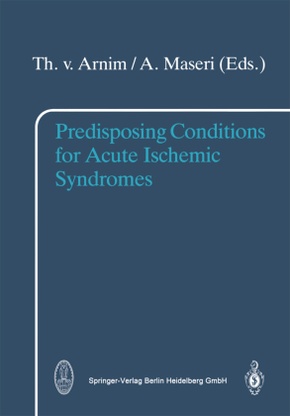Predisposing Conditions for Acute Ischemic Syndromes
| Verlag | Steinkopff |
| Auflage | 2013 |
| Seiten | 185 |
| Format | 17,0 x 1,0 x 24,4 cm |
| Gewicht | 349 g |
| Artikeltyp | Englisches Buch |
| ISBN-10 | 3662094363 |
| EAN | 9783662094365 |
| Bestell-Nr | 66209436A |
"Predisposing conditions for acute ischemic syndromes" contains the proceedings of a conference held in Garmisch-Partenkirchcn, West Germany, October 14 and 15, 1988. The editors of this volume arc most grateful to the authors for their effort to provide manuscripts before the meeting, to the sponsor, Bayer AG, for their gen erous support, and to the publishers for the efficient collaboration, all of which have made the appearance of this book possible. All authors contributed their manu scripts in advance and they arc combined with an edited version orlhe discussions to allow rapid publication. In coronary heart disease the prognosis for patients is largely determined by the occurrence of irreversible ischemic damage to the myocardium. Irreversible eveniS are certainly preceded by a destabilization of a former stable situation. This desta bilization may occur with increasing symptomatology or without apparent warning signs to patient and physician; it may occur over a longer time period or very sud denly. The statemenl, however, holds true that no patient has ever died from stable angina pectoris. Thus, if the prognosis for patients with ischemic heart disease is to be improved, the focus has to be set on recognition and treatment of unstable ischemic syndromes. It was the goal of the conference to gather scientists and clinicans from different fields of research, to get an up-to-date view of the different aspects of unstable ischemic syndromes and to foster interdisciplinary discussions.
Inhaltsverzeichnis:
Circadian variations in the effects of cardiovascular active drugs.- The treatment effects on circadian variation of transient myocardial ischemia.- Inhibition of fibrinolysis in blood: circadian fluctuation and possible relevance to coronary artery disease.- Life-events as precursors of unstable angina pectoris.- Sleep disturbances in pre-infarction patients.- The association between vital exhaustion, unstable angina, and future myocardial infarction.- Plasminogen activator inhibitor-1 and transient myocardial ischemia.- Platelet activation in unstable angina.- Prostaglandin metabolites in unstable angina pectoris patients.- Hemorheologic profile and precursors in myocardial ischemia.- Electrocardiographic patterns of impending coronary closure independent of unstable anginal symptoms.- Holter-monitoring for detecting silent ischemia.- Transient ischemic episodes - a marker for future cardiac events in patients with stable angina pectoris.- Silent ischemia pre and post PTCA - inc idence and prognostic importance.- Acute ischemic syndromes and progression of coronary atherosclerosis.- The pathology of the unstable ischemic syndromes.- Leukotriene production by human vascular tissues: possible link between the nature of the atherosclerotic lesions and their clinical activity.- Preventive strategies for postinfarction patients.- Preventive efficacy of revascularization in unstable angina pectoris.- Anti-ischemic therapy with nisoldipine.- Nisoldipine in PTCA patients.- Concluduing remarks.

